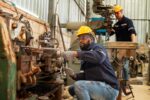
Visit Our Sponsors |
|
|
|
|
|
|
|
|
|
|
|
|
|
|
|
|
|
|
|
|
|
|
|
|
|
|
|
|
|
|
|
|
|
|
|
|
|
|
Charles Dressler, chief innovation officer at Surgere, details the latest iterations of technology that are vitally important to supply chain operations.
Most operators are probably familiar with the need for such technologies as GPS, Bluetooth, passive and active RFID, and Wi-Fi. But some might not be aware of the benefits of “blending” them, Dressler says.
“What's really happened,” he says, “is that you can connect all of that together under a platform that allows you to have visibility, not just from one part of the supply chain, but across it from end to end.”
Tracking and tracing items at sea, in the factory and at the warehouse is made possible by different technologies, such as antennas, handheld devices, cameras and specialized readers. Melding their capabilities together is what’s key, Dressler says. “Companies that can do that will succeed and gain that visibility across the chain.”
At the same time that beneficial visibility is gained, these technologies generate massive amounts of data. “It's just too much data,” Dressler says. “In many cases, you don't know what to do with it because it takes a herculean effort to figure out what those patterns might mean.” Nevertheless, he sees artificial intelligence, just starting in many companies’ supply chains, as a positive. “It will make those frictions that are in the supply chain go away.”
Robotics is revolutionizing the warehouse in several ways, not least in reducing human headcount, he says. Yet, there are areas that remain to be worked out if the benefit of such automation is to be fully realized. Robots and airborne drones need further refinement to keep from running into people and things. “There’s obviously some constraints there,” Dressler says, “but all of that will be solved.”
RELATED CONTENT
RELATED VIDEOS
Timely, incisive articles delivered directly to your inbox.






